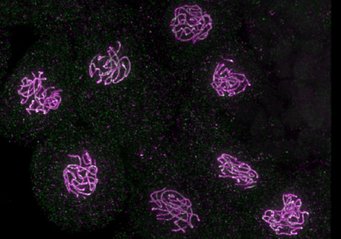Molecular mechanism of meiosis

Meiosis is an essential stage in the life cycle of sexually reproducing organisms, during which the number of chromosomes is reduced from two sets in the parent to one set in gametes. Meiosis is also the stage of development when genetic recombination occurs, thus constituting the heart of genetic shuffling at each generation and the basis of Mendelian heredity. For example, your unique chromosomes were assembled during meiosis in your parents. Half of your chromosomes were assembled during the embryonic life of your mother, and the other half in paternal meiosis, typically nine months and a few weeks before your birth.
Improving our understanding of meiosis has important implications in medicine. This is because meiotic errors are astonishingly frequent in humans, where they are the major cause of trisomies and pregnancy loss. Deciphering the how and why of meiotic recombination is also crucial for our understanding of the evolution of eukaryotes. Moreover, gaining control over the process of meiosis and recombination will allow plant breeders to more easily combine beneficial genes into elite crop varieties that are more productive and that exhibit heightened resistance to pests and harsh environmental conditions.

In our team, we aim to decipher the mechanisms of meiosis including recombination, cell cycle control, and chromosome distribution using the power of the model plant Arabidopsis thaliana (thale cress), in combination with molecular genomics, genetic screens, and microscopy.
MECHANISMS AND REGULATION OF MEIOTIC RECOMBINATION
Crossovers between the non-sister chromatids of two homologous chromosomes during meiosis result in the exchange of genetic material and thus recombinant chromosomes. In this way, crossovers enhance genetic diversity. In addition, crossovers are essential for proper chromosome distribution in most eukaryotes. The number and distribution of crossovers along chromosomes are tightly regulated. There is at least one crossover per chromosome, rarely more than three, while certain locations in the genome are frequently the sites of crossovers, and other regions (e.g., regions situated close to the centromeres of chromosomes) completely lack them. We use diverse genetic screens to understand the mechanisms of crossover formation and regulation. We aim to uncover both pro- and anti-crossover mechanisms and have identified and characterized several mechanisms that greatly limit crossovers. We now aim to identify additional mechanisms that promote or prevent crossovers – notably close to centromeres – and which control crossover distribution among and along the chromosomes.
DIVERSITY OF MEIOTIC RECOMBINATION
Beyond the analysis of recombination mechanisms in a few laboratory strains, we aim to explore the extent of the diversity of crossover frequencies in the wild as well as the underlying genetic determinants. Recent advances in DNA sequencing now make it possible to analyze recombination in multiple individuals. Because of its large geographic distribution, Arabidopsis is a highly suitable model for exploring the question of recombination diversity and its potential adaptive value.
MODIFICATION OF CELL CYCLE AND CHROMOSOME DISTRIBUTION DURING MEIOSIS
In this project, we analyze two key features that allow ploidy reduction at meiosis:
• the control of the number of cell divisions, which must be exactly two
• the control of chromosome distribution, which separates homologues at the first division and sisters at the second division
Dedicated genetic screens and downstream functional analyses allow us to decipher mechanisms that prevent meiocytes from exiting meiosis after a single division or prevent entry into a third division. We are also exploring the factors that regulate kinetochore orientation and sister chromatid cohesion during meiosis I and II.
EXPANDING THE TOOL BOX FOR PLANT BREEDING

A better understanding of meiosis allows us to propose disruptive innovations for plant breeding. Through international collaborations, we have shown that crossovers can be massively increased in various crops such as pea, tomato, and rice. We have also taken advantage of accumulated knowledge on meiosis to engineer clonal reproduction through seeds in Arabidopsis and rice.


